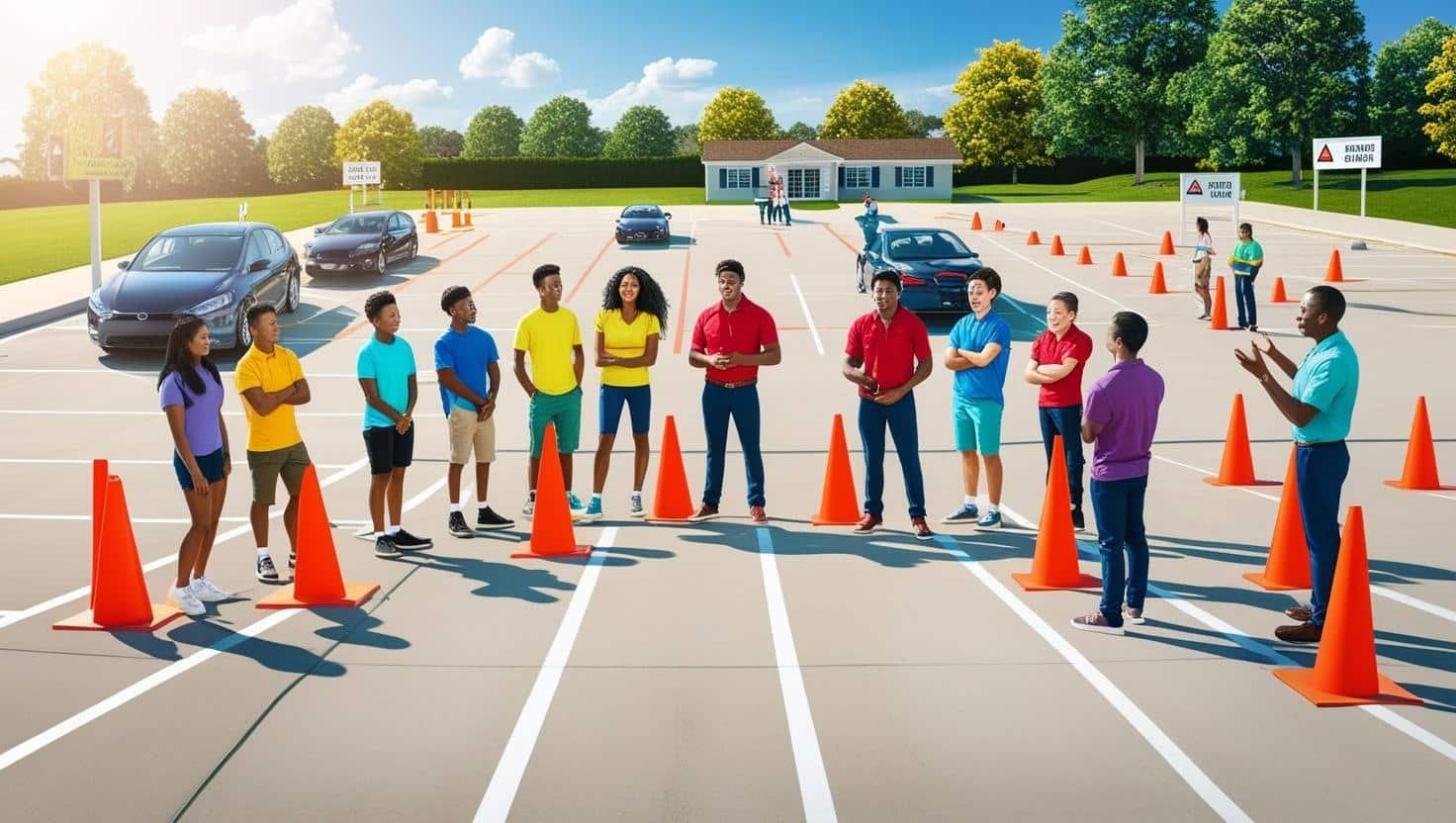1. Course Overview
- Audience: New and experienced drivers who want to improve their driving skills and learn defensive driving techniques.
- Format: Combination of slide presentations (theory) and practical video demonstrations.
- Objectives:
- Understand the fundamentals of defensive driving.
- Learn how to identify and respond to potential road hazards.
- Develop strategies to minimize risks and avoid accidents.
- Practice safe driving habits in various road and weather conditions.
2. Course Outline
Module 1: Introduction to Safe Driving
Slides (Key Points)
- What is Safe Driving?
- Definition: Safe driving is about being aware, responsible, and prepared for unexpected road situations.
- Importance of a proactive mindset.
- Essential Driver Responsibilities
- Following traffic rules and regulations.
- Ensuring vehicle is in good condition (tires, brakes, lights).
- Maintaining focus and avoiding distractions (phone, loud music, etc.).
- Setting the Right Attitude
- Patience and courtesy on the road.
- Understanding that safety is a shared responsibility.
Video Idea
- Title: “Safe Driving Basics”
- Content:
- Short introduction by the instructor explaining the key principles of safe driving.
- Montage showing both good and bad driving examples, highlighting the difference in attitude and awareness.
Module 2: Defensive Driving Strategies
Slides (Key Points)
- The Defensive Driving Mindset
- Always anticipate the actions of other drivers.
- Keep a safe following distance (e.g., the “3-second rule”).
- Scan the road ahead, check mirrors frequently.
- Common Hazards and How to Respond
- Sudden braking by the car in front.
- Vehicles merging unexpectedly.
- Road debris, potholes, and slippery surfaces.
- Maintaining Focus
- Minimizing visual, manual, and cognitive distractions.
- Strategies to stay alert (e.g., taking breaks on long trips, staying hydrated).
- Speed Management
- Understanding speed limits and why they matter.
- Adjusting speed according to weather and traffic conditions.
Video Idea
- Title: “Defensive Driving in Action”
- Content:
- Instructor driving in different scenarios: highway, city streets, and rural roads.
- Voice-over explaining how to anticipate hazards, maintain safe distances, and react appropriately.
Module 3: Vehicle Control and Positioning
Slides (Key Points)
- Proper Seating and Steering
- Seat adjustment for optimal visibility.
- Hand positioning on the steering wheel (e.g., “9 and 3 o’clock” recommended by many instructors).
- Lane Discipline
- Staying centered in your lane.
- Proper lane changes (mirror, signal, blind spot checks).
- Respect for cyclists and motorcyclists.
- Braking Techniques
- Smooth braking vs. sudden braking.
- Threshold braking in emergency situations.
- Anti-lock Braking System (ABS) basics.
- Cornering and Turning
- Slowing down before the turn, accelerating gently out of it.
- Proper use of turn signals.
Video Idea
- Title: “Mastering Vehicle Control”
- Content:
- On-road demonstrations with an instructor pointing out best practices.
- Close-up shots of steering wheel, footwork on pedals, and correct lane positioning.
Module 4: Adverse Conditions and Night Driving
Slides (Key Points)
- Driving in Bad Weather
- Rain: reduce speed, turn on headlights, avoid standing water (hydroplaning).
- Snow/Ice: gentle acceleration and braking, increased following distance, use of winter tires if applicable.
- Fog: use low beams, keep windows clear, reduce speed.
- Night Driving
- Importance of using headlights effectively (low beams vs. high beams).
- Dealing with glare from oncoming traffic.
- Extra caution for pedestrians and wildlife on the road.
- Emergency Preparedness
- Carrying an emergency kit (flashlight, spare tire, blankets, etc.).
- Knowing when to pull over and wait for conditions to improve.
Video Idea
- Title: “Staying Safe in Challenging Conditions”
- Content:
- Real or simulated footage of driving in rain, snow, and fog.
- Tips on how to adjust driving techniques and maintain full control in poor visibility.
Module 5: Dealing with Emergencies
Slides (Key Points)
- Common Emergencies on the Road
- Tire blowouts.
- Brake failure.
- Engine overheating.
- Step-by-Step Responses
- Remain calm, avoid abrupt moves.
- How to steer and brake (if possible) to safely exit traffic.
- Calling for roadside assistance.
- Collisions and Post-Accident Actions
- Ensuring personal safety first.
- Calling emergency services.
- Collecting information and documenting the scene.
Video Idea
- Title: “Handling Roadside Emergencies”
- Content:
- Demonstrations of what to do in a tire blowout scenario (maintain steering, don’t slam brakes).
- Steps to take when the vehicle stalls in traffic.
Module 6: Final Assessment and Review
Slides (Key Points)
- Review of Key Concepts
- Defensive driving principles.
- Speed management, hazard awareness.
- Vehicle control in various conditions.
- Knowledge Check
- Multiple-choice quiz or interactive Q&A.
- Scenario-based questions (“What would you do if…?”).
- Certificate of Completion
- Criteria for passing (e.g., 80% or higher on the final quiz).
- Encouragement for continued learning and practice.
Video Idea
- Title: “Course Wrap-Up and Congratulations”
- Content:
- Instructor summary of the main lessons learned.
- Tips to keep improving driving habits over time.
3. Suggested Delivery Format
- Slides:
- Use a presentation tool (PowerPoint, Google Slides, Keynote) with concise bullet points and relevant visuals (images, diagrams, short text).
- Avoid clutter by using minimal text, focusing on key ideas or statistics.
- Videos:
- Keep each video between 3–10 minutes to maintain engagement.
- Film real driving scenarios or use animations to demonstrate specific maneuvers and road situations.
- Include subtitles or captions for accessibility.
- Interactive Elements (Optional)
- Quizzes or polls embedded within each module.
- Discussion forums or a Q&A session with the instructor if delivered online.
4. Additional Resources
- Handbooks/Guides:
- Local DMV (Department of Motor Vehicles) or driving authority guides (for region-specific rules).
- Checklists for vehicle maintenance and pre-trip inspection.
- Apps and Tools:
- Driving simulators for practice.
- Defensive driving online modules (if you want to supplement the videos).
- Certifications:
- Depending on your region, you may offer an official defensive driving certificate recognized by insurance companies for possible discounts.
5. Best Practices for Engagement
- Keep slides visually appealing: Use high-contrast text and relevant photos/infographics.
- Short, targeted videos: Focus on one main concept or scenario per video.
- Storytelling: Use real-life examples or short stories about accidents prevented by defensive driving techniques.
- Encourage self-assessment: After each module, ask learners to reflect on their own driving habits.
6. Conclusion
By combining clear, concise slide presentations with practical, scenario-based videos, this Safe Driving Course delivers both theoretical knowledge and realistic demonstrations. Encouraging ongoing practice and self-awareness will help learners internalize the concepts and become safer, more confident drivers.



